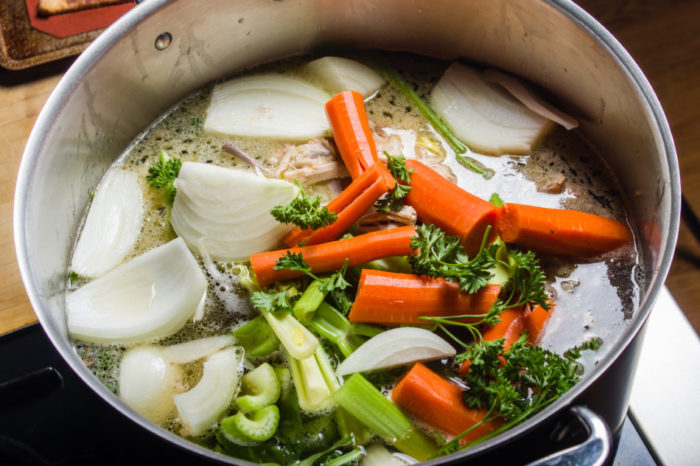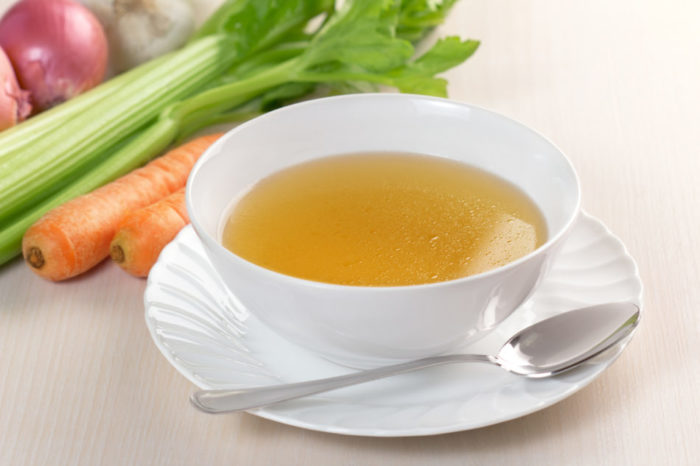For most of us, a comparison of vegetable stock vs broth can feel like splitting hair. They feel pretty much the same and have pretty much the same taste.
So, are they different names of the same thing, or is there even a viable difference? Many people say the difference between either is more of a marketing gimmick.
And to be honest, there is truth to that claim. Vegetable stock and vegetable broth are strikingly similar in taste and use. Let’s take a closer look for a better understanding of the key points.

Vegetable Stock vs Broth – Key Points And Details
Conventional vs Vegetable Stock And Broth
Conventionally, what separates stock and broth is the use of meat and bones. Stock uses plenty of bones and their presence gives it a somewhat more intense flavor. Besides, the gelatin from bones clarifies the stock and gives it a great mouthfeel. Similarly, for broth, it’s the meat that gets it some flavor and mouthfeel.
However, for vegetable stock and broth, there’s no meat or bones to work with and create a clear distinction. So, the conventional differences between stock and broth go out for a toss.

That’s one reason why when people talk about differences between vegetable stock and broth, they follow the template of the conventional stock and broth and just shove the word ‘vegetable’ in place of ‘bone’ or ‘meat’.
This makes it evident that the difference between vegetable broth and stock is more in the terminology rather than the foods themselves. You can generally use vegetable stock and broth interchangeably.
What Is Vegetable Stock?
Much like conventional stock, vegetable stock starts with a base of onions, celery, and carrots. In fact, feel free to use more ingredients from the allium family – leeks, scallions, shallots, and even some garlic is good game. Leftover vegetable bits and pieces are also good additions to vegetable stock.
You could even use trimmings and roots from other vegetables, just remember to use edible items and keep everything hygienic. Place the veggies in the appropriate pan (a stockpot will do) and you can start with browning or caramelizing them.
Once you’re done, add water and other ingredients and let the mix simmer and reduce for an hour or so to allow the liquid to absorb flavors.
After this, the mix is strained to remove the solids. The liquid you get after straining is the vegetable stock.
What Is Vegetable Broth?
Vegetable broth is pretty much the same as vegetable stock, and their preparation is similar as well. You start with chopped veggies like onions, celery, and carrots and soften or caramelize them on the stove. An oven is good for this purpose too, so take your pick.
After this step, you can add water and let the mix simmer for an hour or two to make the broth flavorful. Once ready, strain the mix to get the clear liquid, which is the vegetable broth.
Can I Substitute Vegetable Broth For Vegetable Stock?
Yes, most vegetable broth and vegetable stock are nearly identical in taste, flavor, and consistency. As such, it is possible to use them interchangeably for most uses.
However, if you’re using store-bought vegetable stock or broth, look at the list of additives and artificial flavorings used. Sometimes, these can change the consistency and flavor of the food item.
Most of the time, it’s just a whole lot of salt, but it’s still better to be prepared rather than be surprised!
Why Are Vegetable Stock And Broth So Similar? And How To Make Better Veg Stock
Chicken stock and broth have a clear difference, as do beef stock and broth and similar food products. So why are vegetable stock and broth identical? Well, that’s because they lack the magic ingredient of conventional stock – meat and bones.
Difference Between Conventional Stock And Broth
Conventionally, stock has a richer body and a strong flavor. It works as a base ingredient for several foods, including broth. Generally, it’s not a good idea to eat stock directly as it’s more a base ingredient rather than a finished food. Broth, on the other hand, is a finished and ready to eat food that most people enjoy.
This is because the strong flavors of conventional stock and the lack of seasoning aren’t really loved by the tastebuds. Although when used as a base ingredient for recipes, stock elevates the taste, flavor, and mouthfeel to deliciously amazing levels. Conventionally, broth uses stock as the base ingredient, with added seasoning and additional ingredients.
How Is Vegetable Stock So Different From Conventional Stock Like Chicken Stock
As mentioned earlier, the magical element in conventional stock is meat and bones. Their presence gives stock the amazing mouthfeel, strong flavor, and good consistency.
Vegetable stock doesn’t have meat and bones, and thus, it lacks the same strong flavor and mouthfeel as chicken stock or other similar foods. Here are the reasons why:
- Fat: Meat and bones bring a good amount of fat to the stock. Vegetables don’t have solid fat like subcutaneous fat and bone marrow.
- Collagen: The presence of meat and bones brings collagen to conventional stock. Again, vegetables don’t contain collagen and so, vegetable stock doesn’t have it either. This gives vegetable stock a different consistency and mouthfeel.
- Flavor: Meat stock is usually more flavorful than vegetable stock. After all, it has the same ingredients as vegetable stock and then some more!
To make better vegetable stock, consider adding additional ingredients to fix the lack of the above-mentioned factors. Some of the options are:
- Butter or refined coconut oil: Add a chunk of unsalted butter or refined coconut oil to add some fat to vegetarian stock. Fat that’s a solid at room temperature is the best choice, hence, butter and refined coconut oil work well.
- Parsnips, aquafaba, and kombu: These ingredients are a good way to add some collagen-like richness to the vegetarian stock and give it a better mouthfeel and flavor.
- Starch or thickeners: If you want a thicker, more gelatinous feel from vegetarian stock, consider adding some starch to get a similar effect as gelatin from bones. Agar agar and pectin can work, but use only a small amount.
How To Make Veg Stock?
To make veg stock, start with your choice of vegetables. Usually, these are onions, celery, and carrots. You can also add scallions, shallots, some garlic, leftover vegetables, peels, and similar ingredients.
Put these vegetables in a stock pot and brown them. You can also consider adding other ingredients like mushrooms, parsnips, kombu, miso, and several more. Also, consider adding solid fat and starchy ingredients like those mentioned in the previous section.
Once ready, add water and let the mix simmer for an hour or two. During this time, the mix will reduce considerably and the liquid will have a strong flavor and good consistency.
Strain the mix, while carefully storing the liquid in a jar or pot. This liquid is your delicious and flavorful vegetable stock.
If you want to store it, allow the veg stock to cool and transfer it to yogurt containers, freezer bags, or even an ice cube tray. Properly stored and frozen vegetable stock (like that in freezer bags) can last for a couple of months. If frozen in the ice cube tray, it will be good for a couple of days.
Is Veg Stock Vegan?
Veg stock is usually vegetarian and vegan. Some veg stock may contain butter, which makes it unfriendly for vegans, but it’s relatively rare. If you’re making veg stock at home, you can easily make a vegan-friendly veg stock. Those who buy their veg stock from stores should check the ingredients on the off chance it contains ingredients that aren’t vegan-friendly.
There are some recipes in the wild that suggest using some meat or bones for vegetable stock and broth. Personally, I feel that’s absolutely hokum.
The entire point of making veg stock is for the food to be suitable for vegetarians and vegans. Adding any amount of meat or bones makes it a weak and poorly made chicken stock, beef stock, and other conventional stock.
How To Use Vegetable Broth?
You can enjoy your vegetable broth with some seasoning and salt. It’s also possible to use it with other recipes to add more flavor to them, or to give them a thicker and very flavorful gravy. This combination can add wonderful texture and flavor to your recipe.
Conclusion
Conventionally, there is a notable difference between stock and broth. Stock is more on the side of being bone-based, while broth is meat-based. These differences go out of the window when we put a comparison of vegetable stock vs broth to test.
Since vegetable stock and broth contain neither bones nor meat, they don’t have the same flavor and taste differences as conventional stock and broth. For most uses, vegetable stock and broth are very similar and interchangeable.
